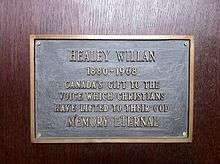Healey Willan
| Healey Willan | |
|---|---|
 | |
| Born |
12 October 1880 London, England |
| Died |
16 February 1968 (aged 87) Toronto, Canada |
| Occupation | Organist, composer |
(James) Healey Willan, CC (12 October 1880 – 16 February 1968) was an Anglo-Canadian organist and composer. He composed more than 800 works including operas, symphonies, chamber music, a concerto, and pieces for band, orchestra, organ, and piano. He is best known for his religious music.
Biography

Willan was born in England and began musical training at age eight, with studies at St. Saviour's Choir School in Eastbourne.[1] He continued at St. Saviour's until 1895, when he began working as organist and choirmaster at several London-area churches. He earned, by examination in organ playing, harmony, counterpoint, history and orchestration, the Royal College of Organists' Associateship in 1897 and Fellowship in 1899. From 1903 to 1913, he was organist and choirmaster of St. John the Baptist Church on Holland Road in London. The Anglo-Catholic Tractarian movement had led to an Anglican revival of plainsong, and in 1910 Willan joined the London Gregorian Association (which strove to preserve and revive "plain-chant"). In 1913 Willan emigrated to Canada.[2]
Willan became organist-choirmaster of Toronto's largest church, St. Paul's, Bloor Street, whose rector, Canon Cody, was later to become Ontario provincial education minister and the chancellor of the University of Toronto. In 1914 Willan was appointed Lecturer and Examiner in music at the University of Toronto. But it was his royalties as a church music composer which allowed him to leave "low church" St. Paul's in 1921 and to become Precentor of the Church of St. Mary Magdalene (Toronto). He remained there until his death. St. Mary Magdalene, under Willan, became a North American mecca for choral and Anglican church musicians. In 1934 he founded the Tudor Singers, which he conducted until it disbanded in 1939.[3]
In 1920 the Toronto Conservatory (now the Royal Conservatory of Music) appointed Willan Head of its Theory Department. Later he became Vice-Principal. The Conservatory was part of the University of Toronto. Students from the conservatory could become eligible to complete the music degree examinations administered by the university.[2] From 1937 to 1950, Willan was University of Toronto Professor of Music and Organist and responsible for the music degree examinations.
His notable pupils included pianist Howard Brown, tenor Gordon Wry, and composers Patricia Blomfield Holt, Walter MacNutt, F. R. C. Clarke, Phyllis Gummer and Kenneth Peacock. See: List of music students by teacher: T to Z#Healey Willan.
When the Order of Canada was established in 1967, it named Willan a Companion. In Britain, it was customary for the Archbishop of Canterbury to occasionally grant very distinguished English cathedral musicians the Lambeth Doctorate, Mus. D Cantuar; in 1956 Willan, "the Dean of Canadian composers"[4] became the first non-English church musician to be so honoured; subsequently, many Canadian universities followed suit. Willan was one of the first Canadian musicians to appear on a Canadian postage stamp. It was not lost on young Canadian musicians that Willan was able to make his livelihood as a composer, and that being a composer was something to which they might realistically aspire.
Compositions
While serving as the organist and choirmaster at St. Paul's, Bloor Street, Willan became interested in the music of another Anglican parish, that of the Church of St. Mary Magdalene. St. Paul's was an evangelical, low church; St. Mary Magdalene's, while much smaller, was notably high church or Anglo-Catholic. By 1920, Willan was assisting with choir practice. In 1921, he resigned his post at St. Paul's and turned his attention to St. Mary Magdalene's. He set about creating a great many liturgical works for use in the church's services and on creating one of the few choirs in North America with expertise in singing unaccompanied music to a very high standard. He remained at St. Mary Magdalene's until shortly before his death, last directing the choir in 1967.
Willan composed some 800 musical pieces, the majority sacred works for choir such as anthems, hymns and mass settings. His non-sacred opus includes some 50 choral works, 100 song arrangements for voice with piano accompaniment, many works for piano solo, for voice with instrumental accompaniment, two symphonies, a piano concerto, chamber works, incidental music for stage works, ballad operas, and at least one important opera (Deirdre).
In 1953, Willan received a commission to write an anthem for the Coronation of Queen Elizabeth II. The resulting anthem, O Lord Our Governour, continues to be frequently performed. Willan's friends clubbed together to pay for his fare to London, so that he could attend the ceremony in person.[5]
Willan is best known for his sacred choral and organ works, which show evidence of his love for plainsong and Renaissance music. For example, many of his liturgical compositions employ western church modes from a thousand years ago and the modality and harmony of late nineteenth-century Russian Orthodox choral music. His vocal lines are significantly more melismatic, his style more contrapuntal and rhythmically much freer than was the case in the liturgical music of his contemporaries. The lively acoustics at Saint Mary Magdalene allowed the melismatic lines to soar and yet linger at the same time. His larger choral works, however, were very Romantic in nature. His rich harmonic palette and luxuriant, soaring melodies stand as testament to his admiration of both Brahms and Wagner.
- His music represents a unique and beautiful combination of styles: both an homage to the sacred music of five centuries ago and a reflection of the innovations of the Romantic/post-Romantic period in which he lived.[6]
Personal
People who remembered Willan from his time at St Mary Magdalene's liked to moderate his somewhat dourly pious public image by quoting him — it was a mainstay of concert talks by Robert Hunter Bell — as to his provenance: "English by birth; Canadian by adoption; Irish by extraction; Scotch by absorption."
Healey Willan Park
| Healey Willan Park | |
|---|---|
|
Wading pool at Healey Willan Park | |
| Location | 504 Euclid Ave, Toronto |
| Coordinates | 43°39′33″N 79°24′47″W / 43.65917°N 79.41306°W |
| Operated by | Toronto Parks |
| Website | Healey Willan Park |
Healey Willan Park is a local public park named in his honour, situated immediately to the east of The Church of St. Mary Magdalene, on the site of the former convent of the Sisters of the Church, which had relocated first to Oakville and later to Burlington. The small rectangular park is separated from the streets by a low metal fence, which provides safety for the children using the playground and wading pool.
Works
- Introduction, Passacaglia and Fugue for Organ in E flat minor (1916)
- Passcaglia and Fugue
- Epilogue
Operas
- L'Ordre du bon temps (1928)
- Prince Charlie and Flora (1929)
- The Ayrshire Ploughman (?)
- Maureen [lost]
- Indian Christmas Play [lost]
- Transit through Fire (1942, written for Canadian Radio)
- Deirdre (1946, written for Canadian Radio, revised for stage in 1965)
Recordings
- In the Heavenly Kingdom: Elora Festival Singers; Noel Edison, conducting; Matthew Larkin, organ; Joseph Schnurr, tenor. Naxos 8.557734 (2006).
- Organ Works: Patrick Wedd, organ; Saint-Jean-Baptiste Church, Montreal. Naxos 8.557375 (2005).
- Faire is the Heaven: The Choirs of the Church of St. Mary Magdalene, Toronto; directed by Giles Bryant. SMM7504
- Tenebrae Responsaries, Missae breves: The Choirs of the Church of St. Mary Magdalene, Toronto; Robert Hunter Bell, conducting. Virgin Classics/EMI, CDC 7243 5 45260 2 2 (1997).
- An Apostrophe to the Heavenly Hosts: Vancouver Chamber Choir; Jon Washburn, conducting. Virgin Classics/EMI, VC 5 45183 2 4 (1996).
- Masses and Motets: The Choirs of the Church of St. Mary Magdalene, Toronto; Robert Hunter Bell, conducting. Virgin Classics/EMI, VC 5 45109 2 (1994).
- Selected Organ Works: Dr. Francis Jackson, Organist. York Minster, England. Columbia Records LP-ML6198 (1960s).
See also
References
- ↑ Healey Willan at St. Martins Chamber Choir. Stmartinschamberchoir.org. Retrieved on 26 August 2011.
- 1 2 Healey Willan at Naxos.com. Retrieved on 26 August 2011.
- ↑ St. Martins Chamber Choir
- ↑ naxos.com
- ↑ Wilkinson, James (2011). The Queen's Coronation: The Inside Story. Scala Publishers Ltd. p. 27. ISBN 978-1-85759-735-6.
- ↑ ''Tribute to Willan''. St. Martins Chamber Choir website, Retrieved on 26 August 2011.
Bibliography
- Clarke, F. R. C. (1982). Healey Willan: Life and Music. Toronto: University of Toronto Press. ISBN 0-8020-5549-4.
- Greig, David; Church of St. Mary Magdalene (Toronto, Ont.) (1990). In the fullness of time : a history of the Church of Saint Mary Magdalene, Toronto. Toronto: Church of Saint Mary Magdalene. ISBN 978-0-9694346-2-7. Cite uses deprecated parameter
|coauthors=(help) - Willan Mason, Mary (2010). The well-tempered listener : growing up with musical parents. Toronto: Words Indeed. ISBN 978-0-9865166-0-3.
Further reading
- McCready, Louise G.: "Healey Willan", in: Famous Musicians (Canadian Portraits; Toronto: Clarke, Irwin & Co., 1957), p. [101]-134, ill. with sketches, incl. a portrait.
External links
- Church of Saint Mary Magdalene
- Encyclopedia of Music in Canada article
- Government of Canada site
- Opera Glass
- Canadian Music Centre article
- Healey Willan Society
- 1959 NFB film about Willan
